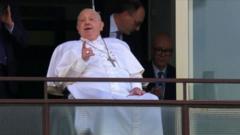The article explores the contrasting experiences of pilgrims in two key Christian locations during the Christmas season.
**Contrasting Christmas Celebrations: Rome's Jubilee vs. Bethlehem's Struggles**

**Contrasting Christmas Celebrations: Rome's Jubilee vs. Bethlehem's Struggles**
As Rome prepares for a jubilant Christmas Jubilee, Bethlehem faces a stark reality of conflict and hardship.
This Christmas Eve marks a significant moment for the Catholic Church as pilgrims gather in Rome for a Jubilee, a special tradition where believers can receive forgiveness for their sins. With hundreds of thousands expected to partake in the celebrations, Rome is busy refining its landmarks, adorned with construction scaffolding, determined to showcase its rich history while welcoming visitors from around the globe.
In stark contrast, the situation in Bethlehem, revered as the birthplace of Jesus, presents a grim picture of enduring conflict and economic strife. The city, home to about 34,000 residents, has been navigating the challenges of living under Israeli occupation, where access is often limited by security measures. Only a small number of pilgrims, perhaps just a few hundred, are predicted to make the arduous journey to Bethlehem, highlighting a poignant disparity in experiences.
The overwhelming contrast is underscored by the physical barriers present in both cities. While Rome is eliminating barriers to create a warm and inviting atmosphere, Bethlehem faces the reality of a towering 40-foot concrete wall at its borders, symbolizing the ongoing tensions in the region.
As the Jubilee in Rome features sacred traditions such as passing through the Holy Doors of designated basilicas for plenary indulgence, Bethlehem struggles with the weight of history marked by generations of war and deprivation. The dichotomy between joy in Rome and the grim reminders in Bethlehem serves as an unsettling reflection of global disparities in religious observation.
In stark contrast, the situation in Bethlehem, revered as the birthplace of Jesus, presents a grim picture of enduring conflict and economic strife. The city, home to about 34,000 residents, has been navigating the challenges of living under Israeli occupation, where access is often limited by security measures. Only a small number of pilgrims, perhaps just a few hundred, are predicted to make the arduous journey to Bethlehem, highlighting a poignant disparity in experiences.
The overwhelming contrast is underscored by the physical barriers present in both cities. While Rome is eliminating barriers to create a warm and inviting atmosphere, Bethlehem faces the reality of a towering 40-foot concrete wall at its borders, symbolizing the ongoing tensions in the region.
As the Jubilee in Rome features sacred traditions such as passing through the Holy Doors of designated basilicas for plenary indulgence, Bethlehem struggles with the weight of history marked by generations of war and deprivation. The dichotomy between joy in Rome and the grim reminders in Bethlehem serves as an unsettling reflection of global disparities in religious observation.























